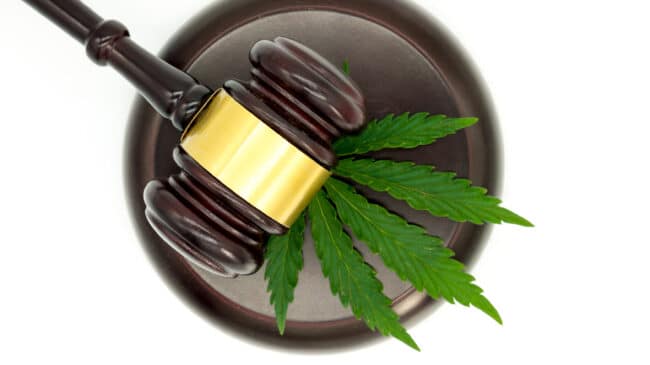Appeal No. 29546
In the Supreme Court
State of South Dakota
Sheriff Kevin Thom, in his official capacity as Pennington County Sheriff, and Colonel Rick Miller, in his official capacity as Superintendent of the South Dakota Highway Patrol,
Plaintiffs/Appellees,
v.
Steve Barnett, in his official capacity as South Dakota Secretary of State,
Defendant,
and
South Dakotans For Better Marijuana Laws, Randolph Seiler, William Stocker, Charles Parkinson, And Melissa Mentele,
Intervenor Defendants/ Appellants.
Brief Of Amici Curiae Cato Institute, The Dkt Liberty Project, Due Process Institute, And Reason Foundation
Appeal From The Circuit Court Sixth Judicial Circuit
Hughes County, South Dakota
I. Over the Past Half-Century, Most States Rejected Federal Marijuana Policy in Favor of Their Own Approach.
In 1937, the U.S. Congress passed the Marihuana Tax Act, which effectively outlawed marijuana under federal law by imposing a prohibitive tax. Later, the 1952 Boggs Act and the 1956 Narcotics Control Act established mandatory sentences for drug-related violations; a first-time offense for marijuana possession carried a minimum sentence of 2–10 years in prison and a fine of up to $20,000.00. Although those penalties were largely repealed by the early 1970s, the Anti-Drug Abuse Act of 1986 reinstated stiff federal penalties for various marijuana offenses.
The possession, use, and distribution of marijuana is controlled at the federal level through the Controlled Substances Act (“CSA”), which classifies drugs into one of five “schedules” (i.e., categories) depending upon their medicinal value, potential for abuse, and psychological and physical effects on the body. See 21 U.S.C. §§ 811-812. Congress placed marijuana into Schedule I, which is the most severely restricted category. Id. at § 812(b)(1). To be listed on Schedule I, a drug must have “no currently accepted medical use and a high potential for abuse” as well as a risk of creating “severe psychological and/or physical dependence.” 21 U.S.C. § 812(b)(1). Among those drugs listed on Schedule II, which are less restricted than marijuana, are cocaine, codeine, OxyContin and methamphetamine. 21 C.F.R. §§ 1308.11-12. The federal government bans the manufacture, distribution and possession of Schedule I drugs, including marijuana. See 21 U.S.C. §§ 829, 841, 844. Scholars have long observed that in enacting the CSA, Congress dramatically expanded federal powers, particularly those arising under Article I, Section 8 of the U.S. Constitution, and that various provisions of the CSA exceed the common-sense bounds of the Commerce Clause.
Nevertheless, federal statutes tell only a small part of the story. Beginning about 50 years ago, individual states began to depart from the federal approach on marijuana. Between 1973 and 1978, 11 states decriminalized the possession or use of small amounts of marijuana. By the mid-1990s, in the face of mounting scientific evidence pointing to marijuana’s medicinal benefits—including its efficacy in treating glaucoma, reducing pain, nausea, and seizures, and alleviating debilitating symptoms associated with various other medical conditions—many states began to legalize marijuana for medicinal purposes. Since 1996, 33 states and the District of Columbia have authorized marijuana for medical use.
South Dakota is a recent participant in this nationwide, state-by-state rethinking of and dissension from federal marijuana law and policy, both with respect to medical and adult use. And for sound reasons. Between 2009 to 2018, 31,883 people were arrested for marijuana in South Dakota, 95 percent of them for possession offenses. In 2018, roughly one out of every ten arrests in South Dakota were for marijuana. What is more, the vast majority of marijuana arrests involved less than seven grams of the drug, and over 40 percent of all such arrests involved just one gram or less. Nor was marijuana possession by persons in South Dakota indicative of other criminal activity: 98.2 percent of marijuana violations in South Dakota from 2007 to 2016 were standalone offenses, meaning the individual was not charged with any other crime, and in 99.1 percent of marijuana arrests, no weapons were seized by police.
These and other metrics reveal the level to which state law enforcement resources were devoted to addressing a single type of low-level non-violent drug offense involving a plant-based controlled substance with no known potential for fatal overdose but proven therapeutic benefits across a broad panoply of illnesses and medical conditions.
To exacerbate matters, the state’s enforcement of marijuana laws, and a constellation of negative consequences that afflict persons arrested for drug offenses, fell most heavily on South Dakota’s youth. Persons under the age of 25 accounted for roughly 63 percent of all marijuana arrests. Further, the fiscal burdens on state taxpayers of the state’s law enforcement practices were substantial. Based on the percentage of arrests made for marijuana compared to the overall law enforcement costs for South Dakota, each marijuana arrest cost the state of South Dakota an estimated $4,000.00.
Like the majority of U.S. citizens, South Dakotans determined that they, their families, their communities and their pocketbooks would be better served by cannabis (i.e., marijuana) policies that departed from the federal government’s commitment to marijuana prohibition. As of this writing, 15 states have legalized marijuana for adult use. Nearly every state that has legalized marijuana for adult use has done so through a citizen-led ballot initiative.
No state that has eliminated criminal and civil penalties for either the medicinal or general adult use of marijuana has reverted to re-criminalizing marijuana, even in part.
